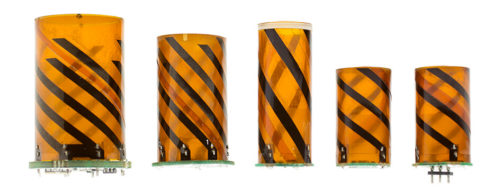Innovations in Quadrifilar Printed Antennas
The degree of integration and components density in modern wireless enabled devices has increased dramatically as integrated circuits have become more powerful and smaller in size. At the same time the integration process of antennas into these devices has become a non-trivial engineering challenge that requires multidisciplinary skills and costly customization. The antenna performance is in fact very much affected by noise, interference and detuning produced by surrounding components.
General Characteristics of Quadrifilar Helix Antennas
The quadrifilar helix antenna is recognized as possibly the best GPS antenna thanks to its characteristics. It has a cardioid-shaped conical pattern, a high front-to-back pattern ratio, Maxtena Helicore Elementsand good circular polarization characteristics. It consists of four equally spaced metallic arms that are wrapped around a cylindrical surface, forming four equally spaced helices.
A feeding network provides signals to these helices with proper phasing to generate the desired radiation pattern. Different types of printed quadrifilar helix antennas (PQHAs) have been proposed as antenna solutions for mobile satellite communication systems. These antennas are preferred to crossed dipoles and patches for their small structure, insensitivity to ground or hand proximity effects, flexibility in shaping radiation pattern, and wide circularly polarized beam. Printed quadrifilar antennas are also usually preferred over wired quadrifilar antennas since they offer the advantages of lightweight, low cost, high-dimensional stability, and ease of fabrication.

Size and weight are very often the key constraints for portable hand held terminals and have been driving the development of smaller and lighter antennas over the last couple of decades. Size reduction for PQHA has traditionally been obtained by printing the antenna on a cylinder with high-dielectric permittivity, like ceramic. However, the dielectric constant of ceramic materials is difficult to control during mass production, and the batch-to-batch consistency can often be very poor. This variation in the dielectric constant requires individual tuning of the antennas with significant impact on the production costs.
Maxtena Helicore Innovations
Maxtena has developed a family of high performance PQHAs based on its proprietary HeliCore® technology. This technology provides an extremely flexible platform for fitting different products with varying specifications in terms of patterns, polarization, efficiency and size. The antenna size reduction is based on the miniaturization and optimization of the feeding network, hosted on a small printed circuit board, while the antenna element can be realized as a flexible printer circuit (FPC) wrapped around a cylindrical plastic support. The absence of ceramic materials allows for tighter control of the antenna center frequency and provides better consistency during mass production. Moreover, HeliCore® technology is based on the functional decoupling between the antenna element and the feeding network, resulting in a radiation pattern that maintains the same characteristics over a very wide bandwidth, well beyond the impedance bandwidth of the antenna itself.
The unique characteristics of the HeliCore® technology ensure high performance and straightforward integration under the most demanding constraints. Obviously, early consideration of the antenna integration in the design process is always the best approach and leads to optimal results in terms of cost and performance. The biggest challenge is in minimizing the interference between the antenna and other components so that the radiation performance is not compromised.